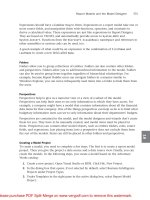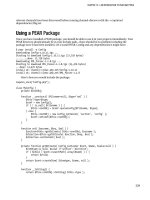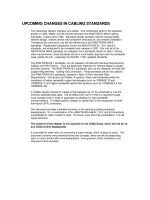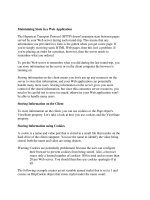Tài liệu Managing time in relational databases- P8 pptx
Bạn đang xem bản rút gọn của tài liệu. Xem và tải ngay bản đầy đủ của tài liệu tại đây (334.67 KB, 20 trang )
prevent us from inserting another row for policy P861, with an
effective begin date of, let’s say, April 2010?
The answer is that Asserted Versioning explicitly recognizes
and
enforces temporal entity
integrity, a concept we introduced
in the preceding chapter. As we said there, any Asserted
Versioning implementation must reject a transaction that would
create a version whose effective time period [
intersects], within
shared assertion time, even a single effective-time clock tick
included in another version of that object already in the table.
Most physical transactions against bi-temporal tables are
inserts. When we distinguish inserts from updates, as we have
done here, we are talking about logical transactions against
bi-temporal tables, transactions we call temporal transactions.
The Temporal Foreign Key
A temporal foreign key (TFK) is analogous to a normal foreign
key, and serves much the same purpose; but it is one which the
DBMS does not know how to use. A foreign key, at the schema
level, points from one table to a table it is dependent on. At
the row level, a foreign key value points from one row in the for-
mer table to one row in the latter table.
At the schema level, a TFK also points from one table to a
table it is dependent on. But at the row level, it points from
one row, which is a version, to a group of one or more rows
which make up an episode of the object whose oid matches
the oid in the temporal foreign key.
So a TFK does not point to a specific row in its referenced
table. But it also does not point to the episode which the version
containing it is dependent on. It points only to an object. In our
example, it says only that this version of policy P861 belongs to
client C882. But since no row in particular represents a client,
i.e. since clients are themselves versioned, and since their vers-
ions are also asserted, the TFK points to no row in particular.
Since there may be multiple episodes for any object, the TFK
points to no episode of that object in particular.
The very existence of a TFK instance does make the claim,
however, that there is an episode of the designated object in
the referenced table, and that the effective time period of that
episode in the referenced table includes, i.e. is filled by ([
fills
–1
]),
the effective time period of the version which contains the refer-
ring TFK. And it is one of the responsibilities of the Asserted
Versioning Framework to insure that for every TFK instance in
a database, there is exactly one such episode. Although the TFK,
by itself, does not designate this parent episode, the TFK together
Chapter 6 DIAGRAMS AND OTHER NOTATIONS
123
with the assertion and effective time periods on the child row
does designate it.
The Effective Time Period
A pair of dates defines the effective time period for each ver-
sion. As we explained in Chapter 3, we use the closed-open con-
vention, for both effective dates and assertion dates, in which a
time period starts on its begin date, and ends one clock tick prior
to its end date. Effective begin and end dates, of course, indicate
when the version began and ceased to be effective. They delimit
the period of time during which the object was as that row in the
table describes it to be.
With non-temporal tables, we create a version of an object by
the act of inserting a row into its table. But because there are no
dates to delimit the effective time period of the row, the row goes
into effect when it is physically created, and remains in effect
until it is physically deleted. And while it exists in the table, no
other versions of that object may co-exist with it. For if they
did, there would be two or more statements each claiming to
be the true description of the object during the entire time that
all of them co-existed in the table.
The Episode Begin Date
Just as versions have effective time periods, episodes do too.
An episode’s begin date is an effective begin date, and it is the
same as the effective begin date of its earliest version. An
episode’s end date, although not explicitly represented in the
Asserted Versioning schema, is the same as the effective end date
of its latest version.
The episode begin date is repeated on every row so that by
looking at an episode’s latest version we can determine the entire
effective time period for the episode itself. By the same token, we
can also look at any version and know that from its episode
begin date to its own effective end date, its object was continu-
ously represented in effective time. The ability to do this without
retrieving and looking at multiple rows will be important, later
on, when we see how temporal referential integrity is enforced.
The Assertion Time Period
Using the same closed-open convention, this pair of dates
indicates when we began to assert a version as true and when,
if ever, we stopped asserting that it is true. Even when a version
124
Chapter 6 DIAGRAMS AND OTHER NOTATIONS
ceases to be in effect, i.e. even when it has an effective end date
in the past, we will usually continue to assert that, during its
effective time period, it was a true description of what its object
was like at that time.
However, and this is a very important point, there are
exceptions. With both the Asserted Versioning and the standard
temporal models, assertions may end even though the rows
that made them remain in the table. We terminate assertions if
and when we learn that they are mistaken, that the statement
they make is not true. In addition, with Asserted Versioning,
but not with the standard temporal model, rows can also be
created whose assertion is postponed until some later point in
time.
With non-temporal tables, we assert a row to be true by the
act of inserting it into its table, and we cease to assert that it is
true by deleting it from its table. With non-temporal tables, the
assertion time period of a row coincides with the row’s physical
presence in the table. In these cases, the assertion begin date
is the same as the row creation date. Also, in most cases, once
we assert a row to be true, we continue to do so “until further
notice”.
The Row Creation Date
The row creation date is the date the row is physically
inserted into its table. In most cases, the row creation date will
be identical with the assertion begin date. In the standard tem-
poral model, it always is, and consequently, in that model, the
two dates are not distinguished. However, in our Asserted
Versioning implementation of bi-temporal data management,
it is valid to create a row with an assertion begin date in the
future. Thus, for Asserted Versioning, it is necessary to have a
row creation date which is distinct from the assertion begin
date.
The Basic Asserted Versioning Diagram
Figure 6.2 is an example of the basic diagram we will use to
illustrate Asserted Versioning. The schema in this diagram was
explained in the previous section. Now it’s time to explain how
to read the diagram itself. Figure 6.2 shows us the state of an
asserted version table after a temporal insert transaction which
took place on January 2010, and a temporal update transaction
which took place on May 2010.
Chapter 6 DIAGRAMS AND OTHER NOTATIONS
125
On January 2010, a temporal insert transaction was processed
for policy P861.
1
It said that policy P861 was to become effective
on that date, and that, as is almost always the case when a tem-
poral transaction is processed, was to be immediately asserted.
Then in May, a temporal update transaction for that policy
was
processed. The transac
tion changed the copay amount from
$15 to $20, effective immediately. But this invalidated row 1
because row 1 asserted that a copay of $15 would continue to
be in effect after May. So as part of carrying out the directives
specified by that temporal transaction, we withdrew the asser-
tion made by row 1, by overwriting the original assertion end
date of 12/31/9999 on row 1 with the date May 2010.
When a row is withdrawn, it is given a non-12/31/9999 asser-
tion end date. Withdrawn rows, in these diagrams, are graphically
1
The format for showing bi-temporal dates, in the text itself, is slightly different from
the format used in the sample tables. For example, a date shown as “Jan10” in any of
the tables will be written as “January 2010” in the text. Time periods are shown in the
text as date pairs with the month still shortened but the century added to the year.
Thus “[Feb 2010 – Oct 2012]” designates the time period beginning on February 2010
and ending one clock tick before October 2012, but would be represented in the
diagram by “Feb10” and “Oct12”.
May10 UPDATE Policy [P861, , , $20]
1
Jan10
2
1
May10
3
The table as asserted from May 1
st
, 2010 until further notice
The table as asserted from Jan 1
st
, 2010 to May 1
st
, 2010
Jan
2014
Jan
2013
Jan
2012
Jan
2011
Jan
2010
Temporal Foreign Key
Episode Begin Date
Effective Period Assertion Period
Row Creation Date
Row
#
1
2
3P861
P861
P861
Jan10
Jan10
Jan10
Jan10
Jan10
row-crt
copay
type
epis-
beg
asr-endasr-beg
eff-end
eff-beg
oid
client
Jan10
May10
May10
May10
May10
May10
May10
May10
Mar10
C882
C882
C882
HMO
HMO
HMO
$15
$15
$20
9999
9999
9999
9999
Temporal Primary Key
Figure 6.2 The Basic Asserted Versioning Diagram.
126
Chapter 6 DIAGRAMS AND OTHER NOTATIONS
indicated by shading them. In addition, every row is represented
by a numbered rectangular box on a horizontal row of all versions
whose assertions begin on the same date. We will call these hori-
zontal rows assertion time snapshots. These snapshots are located
above the calendar timeline, and when their rectangular boxes
represent withdrawn rows, those boxes are also shaded. So in Fig-
ure
6.2, the box
for row 1 is shaded.
After row 1 was withdrawn, the update whose results are
reflected in Figure 6.2 was then comple
ted b
y inserting two rows
which together represent our new knowledge about the policy,
namely that it had a copay of $15 from January 2010 to May
2010, and had a copay of $20 thereafter.
The clock tick box is located to the left of the transaction, at
the
top of the diagram
. It tells us that it is currently May 2010,
in this example. This is graphically indicated by the solid vertical
bar representing that month on the calendar timeline above the
sample table. In this example, rows 2 and 3 have just been cre-
ated. We can tell this because their row create date is May 2010.
The first row is no longer asserted. It has been withdrawn. It
was first asserted on January 2010, but it stopped being asserted
as part of the process of being replaced as a current assertion by
row 2, and then superceded by row 3. This is indicated by the
May 2010 value in row 1’s assertion end date and the May 2010
value in the assertion begin dates of rows 2 and 3. It is graph-
ically indicated by the two assertion time snapshots above and
to the left of the timeline. Each snapshot shows the rows of the
table that were currently asserted starting on that date. So from
January 2010 to May 2010, row 1 is what we asserted about
policy P861. From May 2010 forwards, rows 2 and 3 began to
be asserted instead.
We say “instead” because rows 2 and 3 together replace and
supercede row 1, in the following sense. First of all, they describe
the same object that row 1 describes, that object being policy
P861. Second, rows 2 and 3 together [equal] the effective time
period of row 1, the period [Jan 2010 – 12/31/9999]. Row 2’s
effective time period is [Jan 2010 – May 2010]. Then, without
skipping a clock tick, row 3’s effective time period is [May 2010
– 12/31/9999]. Row 2 includes the part of row 1’s effective time
whose business data is not changed by the update; so we will
say that row 2 replaces that part of row 1. Row 3 includes the part
of row 1’s effective time whose business data is changed by the
update; so we will say that row 3 supercedes that part of row 1.
In our illustrations, 9999 represents the latest date that the
DBMS can represent. In the case of SQL Server, for example, that
date is 12/31/9999. This date does not represent a New Year’s Eve
Chapter 6 DIAGRAMS AND OTHER NOTATIONS
127
some 8000 years hence. But it is a date as far as the DBMS is
concerned. The importance of this “dual semantics” will become
important later on when we explain how Asserted Versioning
queries work.
Notice that all three rows in this example have assertion
begin dates that are identical to their corresponding row creation
dates. In the standard temporal model, a transaction time period
is used instead of an assertion time period; and with transaction
time periods, the begin date is always identical to the row crea-
tion date, and so a separate row creation date is not necessary.
But in the Asserted Versioning model, assertion begin dates
and row creation dates are not semantically identical, and they
do not necessarily have the same value in every row in which
they appear. With Asserted Versioning, while no assertion begin
date can be earlier than the corresponding row creation date,
it can be later. If it is later, the transaction which creates the
row is said to be a deferred transaction, not a current one.
The row it creates in an asserted version table is said to be a
deferred assertion, not a current one. Such rows are rows that
we may eventually claim or assert are true, but that we are not
yet willing to.
In this example, both before and after May 2010, the effective
end date for policy P861 is not known. But sometimes effective
end dates are known. Perhaps in another insurance company,
all policies stop being in effect at the end of each calendar year.
In that case, instead of an effective end date of 12/31/9999 in
rows 1 and 3, the example would show a date of January 2011
(meaning, because of the closed-open convention, that the last
date of effectivity for these policies is one clock tick prior to Jan-
uary 2011, that being December 2010).
We turn now to the graphics, the part of Figure 6.2 abo
ve the
sample table.
The purpose of these graphics is to abstract from
the business details in the sample table and focus attention
exclusively on the temporal features of the example.
Above a calendar which runs from January 2010 to February
2014,
there are two
horizontal rows of rectangular boxes. These
rows are what we have already referred to as assertion time
snapshots, with each rectangular box representing one version
of the associated table. The lowest snapshot in a series of them
contains a representation of the most recently asserted row or
rows. These most recently asserted rows are almost always cur-
rently asserted and usually will continue to be asserted until fur-
ther notice.
There are, however, two exceptions. Neither of them is part of
the standard temporal model, but both of them support useful
128
Chapter 6 DIAGRAMS AND OTHER NOTATIONS
semantics. One exception is created by the presence of deferred
assertions in the table which are, by definition, assertions whose
begin dates, at the time the transaction is processed, lie in the
future. The other exception is created when assertions are with-
drawn without being replaced or superceded, i.e. when after a
certain point in time we no longer wish to claim that those
assertions ever were, are or will be a true description of what
their object was, is or might be like during some stretch of effec-
tive time. But as we said earlier, we will not discuss deferred
assertions until several chapters from now, at which time we will
also discuss withdrawn assertions that are not replaced and/or
superceded by other assertions.
Each of these assertion time snapshots consists of one or
more boxes. As we said, each box contains the row number of
the row it represents. The vertical line on the left-hand side of
each box corresponds to the effective begin date of the row it
represents. In this illustration, only one of the boxes is closed,
in the sense of having a line on its right-hand side. The other
two are open both graphically and, as we will see, semantically.
Let’s consider these boxes, one at a time. The box for row 1 is
open-ended. This always means that the corresponding row has
an effective end date of 12/31/9999. The box directly below the
box for row 1 represents row 2. Because that box is closed on
its right-hand side, we know that the row it represents has a
known effective end date which, in this case, is May 2010.
In these boxes that line up one under the other, the business
data in the rows may or may not be identical. If the business
data is identical, then the box underneath the other represents
a replacement, and we will indicate that it has the same business
data as the row it replaces by using the row number of the row it
replaces as a superscript. But if the business data in two rows for
the same object, during the same effective time period, is not
identical, then the row represented by the lower box supercedes
the row represented by the upper box, and in that case we
will not include a superscript. This convention is illustrated in
Figure 6.2,
in which the box
for row 2 has a superscript
designating row 1, whereas the box for row 3 has no superscript.
The box directly to the right of the box for row 2 represents
ro
w 3. We
can tell that the two rows are temporally adjacent
along their effectivity timelines because the same vertical line
which ends row 2’s effective time period also begins row 3’s
effective time period. So this diagram shows us that there is an
unbroken effective time period for policy P861, which began to
be asserted on May 2010, and which extends from row 2’s effec-
tive begin date of January 2010 to row 3’s effective end date of
Chapter 6 DIAGRAMS AND OTHER NOTATIONS
129
12/31/9999, this being exactly the same effective time period
previously (in assertion time) represented by row 1 alone.
This description of Asserted Versioning’s basic diagram has
focused on a sample table whose contents reflect one temporal
insert transaction, and one temporal update transaction.
Additional Diagrams and Notations
Before proceeding, we need a more flexible way to supple-
ment English in our discussions of Asserted Versioning. In the
last section, we used what we called the “basic diagram” of an
asserted version table. That diagram contains five main compo-
nents. They are:
(i) The current clock tick, which indicates what time it is in the
example;
(ii) A temporal insert, update or delete transaction;
(iii) A calendar timeline covering approximately four years, in
monthly increments;
(iv) A stacked series of assertion time snapshots of the table
used in the example; and
(v) The table itself, including all rows across all effective and
assertion times.
We will still need to use this basic diagram to illustrate many
points. But for the most part, discussions in the next several
chapters will focus on effective time. So we will often use a dia-
gram in which rows in past assertion time are not shown in the
sample table, and in which there are no assertion time snapshots
either.
So, leaving assertion time snapshots out of the picture, we
will often use the kind of diagram shown in Figure 6.3.
And
sometimes we will
simply show a few rows from a sample table,
as in Figure 6.4.
Sep10 UPDATE Policy [P861, , PPO] Jun 2010
Jan
2014
Jan
2013
Jan
2012
Jan
2011
Jan
2010
Row
#
1
2
3
P861
P861
P861
oid
eff-beg
eff-end
asr-beg
asr-end
client
epis-
beg
Jan10
Apr10
Apr10
Apr10
Jan10
Jan10
Jan10
Jan10
C882
C882
C882
HMO
HMO
PPO
$15
$20
$20
Jul10
Jan10
Apr10
9999
9999
9999
Jul10
Jul10
Oct10
Jul10
type copay
row-crt
Figure 6.3 The Effective Time Diagram.
130
Chapter 6 DIAGRAMS AND OTHER NOTATIONS









